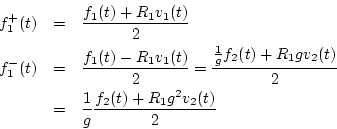The ideal transformer, depicted in Fig. G.21 a, is a
lossless two-port electric circuit element which scales up voltage by
a constant ![]() [102]. In other words, the voltage at
port 2 is always
[102]. In other words, the voltage at
port 2 is always ![]() times the voltage at port 1. Since power is
voltage times current, the current at port 2 must be
times the voltage at port 1. Since power is
voltage times current, the current at port 2 must be ![]() times the
current at port 1 in order for the transformer to be lossless. The
scaling constant
times the
current at port 1 in order for the transformer to be lossless. The
scaling constant ![]() is called the turns ratio because
transformers are built by coiling wire around two sides of a
magnetically permeable torus, and the number of winds around the port
2 side divided by the winding count on the port 1 side gives the
voltage stepping constant
is called the turns ratio because
transformers are built by coiling wire around two sides of a
magnetically permeable torus, and the number of winds around the port
2 side divided by the winding count on the port 1 side gives the
voltage stepping constant ![]() .
.
![\includegraphics[width=\twidth]{eps/lTransformer}](img1944.png) |
In the case of mechanical circuits, the two-port transformer relations appear as

We now want to see what happens when we convert the transformer describing
equations to the wave variable formulation. Let ![]() and
and ![]() denote
the reference impedances chosen on the port 1 and port 2 sides,
respectively, and define velocity as positive into the transformer. Then
denote
the reference impedances chosen on the port 1 and port 2 sides,
respectively, and define velocity as positive into the transformer. Then

Similarly,

We see that choosing

The corresponding wave flow diagram is shown in Fig. G.21 b.
Thus, a transformer with a voltage gain ![]() corresponds to simply
changing the reference impedance from
corresponds to simply
changing the reference impedance from ![]() to
to ![]() , where
, where
![]() . Note that the transformer implements a change
in reference impedance without scattering, unlike what happens
when wave impedance is changed in a waveguide.
. Note that the transformer implements a change
in reference impedance without scattering, unlike what happens
when wave impedance is changed in a waveguide.